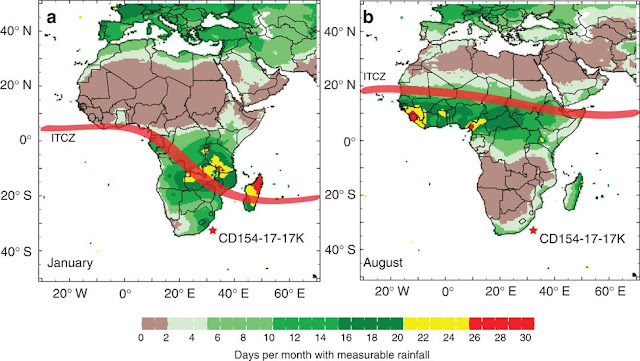Ecosystem Services and the Distribution of Water in Africa
Before attempting to dive into discussion of the
complexities of ecosystem services it is important to briefly outline the wider
context they are being discussed in. Thus this second blog will involve little
direct discussion of Ecosystem Services, but look at one of the major factors effecting
water availability in Africa, variation in precipitation. This will involve mostly outlining of climatic
factors, as well as some limited discussion of other factors which impact distribution of water and it's availability.
The context of water management in is Africa very different
to almost every other context, with the only similar example perhaps being from
Australia, due to the huge variability in distribution over both time and space
across the continent. This variation is predominantly controlled by levels of
precipitation, with climatic impacts of this ‘superimposed upon regional
factors’ (Nicholson, 1996) of temperature, evapo-transpiration,
topography and soil structures in Africa which impact the distribution of water
once it has been released as precipitation (UNEP, 2010) .
Levels of precipitation are obviously incredibly important for Ecosystem Services, with water essential for driving all ecosystems, whether they directly or indirectly provide services for human consumption.
Determinants of Precipitation Levels Across Africa
The main climatic driver of water distribution in Africa is the ITCZ, or the Inter-Tropical Convergence Zone. This is a function of Hadley Cells, the formation of which is a cyclical process, but can be seen as beginning where insolation is highest, at the thermal equator or the ‘latitude of the maximum surface heating’
- At the thermal equator air is warmed and rises through convection, creating low pressure.
- This causes air to flow in to replace it, with these flows known as the trade winds. This replacement air is subsequently heated, continuing the process.
- The heated air rises and cools, shedding accumulated moisture as precipitation.
- This elevated air then begins moving pole-wards, away from the equator.
- Meanwhile cooling continues, eventually causing descent, and condensation, and so significantly less precipitation occurs where this occurs.
- The resultant pressure difference then causes the air to flow back towards the Equator.
 |
| Annual Water Balance, Source-UNEP, 2010 |
Therefore rainfall is generally highest near to the equator, with levels of precipitation reducing towards the poles, both north and southwards away from the ITCZ.
The impact of this is evident in the annual water balance diagram from the United Nations Environment Program and from Ziegler et al.. This highlights the impact the ITCZ and precipitation has on overall water availability across Africa
Although the ITCZ does play a crucial role, there are other sources of rainfall, such as orographic rainfall influenced by local topography, as well as from maritime sources of rainfall.
Furthermore although water surpluses do mirror rainfall, it is important to note that there are impacts beyond this that impact access to water. These include the impact of evapo-transpiration, which can remove up to 90% of rainfall. Similarly, it can also be influenced by local geology, with some areas having higher filtration rates meaning water feeds into groundwater and aquifers rather than surface sources. This can have significant impacts, particularly when working in tandem with tectonics, as evidenced by the impact of rift valleys in East Africa. This has led to the formation of narrow and deep lakes, with limited surface areas reducing the impacts of high seasonal evapo-transpiration.
Nonetheless, levels of precipitation play a central role in determining the availability of water across Africa's ecosystems and their services. As evidenced by the stark impact that another aspect of the ITCZ has on African water availability.
Wet Hot African Summer
The ITCZ is more than simply a determinant of spatial distribution of water, and it also has a stark temporal impact. This is due to the location of the ITCZ varying seasonally, impacted by shifts in the thermal equator resultant from the changing relative locations of the Sun and the Earth. This causes the ITCZ to oscillate between 20 degrees north and south of the Equator, as shown in the diagram below. Subsequently the rainfall impacts to follow, and thus a significant variation in levels of rainfall in areas at the outer limits of it's reach.This results in a Wet and Dry Season in some areas, with the northernmost extent of the ITCZ coming in August leading to a wet season across the Sahelian regions then, with the mirrored impact south of the equator coming in January.
 |
| Seasonal Oscillation of the ITCZ, Source-Ziegler et al, 2013 |
This has a massive impact on the seasonal the availability of water, with African rivers some of the most seasonally variable in the world, having the highest co-efficients of variation in river discharge.
This availability is incredibly important in supporting ecosystems services in Africa, and has given rise to specific ecosystems, coping strategies and problems. The impacts and importance of these for ecosystem services will be highlighted in my next few blogs.
No comments:
Post a Comment